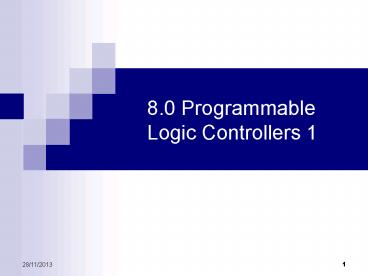8.0 Programmable Logic Controllers 1 - PowerPoint PPT Presentation
1 / 75
Title:
8.0 Programmable Logic Controllers 1
Description:
8.0 Programmable Logic Controllers 1 Programmable Logic Controllers Books PLC Programming for Industrial Automation by Kevin Collins ISBN 978-1-84685-598-6 ... – PowerPoint PPT presentation
Number of Views:167
Avg rating:3.0/5.0
Title: 8.0 Programmable Logic Controllers 1
1
8.0 Programmable Logic Controllers 1
2
Programmable Logic Controllers
- Introduction/background
- Connections
- Architecture
- Programming
3
Books
- PLC Programming for Industrial Automation by
Kevin Collins - ISBN 978-1-84685-598-6
- Programmable Logic Controllers
- Festo basic level TP 301
- Order number093311
4
8.1 Introduction/background
5
Background
- The first Programmable Logic controller was
developed about 1968 by engineers in General
Motors - The original task of a PLC involved the
interconnection of input signals according to a
program and to switch the corresponding output
6
Background
- The task that the PLC can perform has rapidly
multiplied - The plc now performs the logic functions of
relays, timers, counters and sequencers.
7
Why use a PLC ?
8
Why use a PLC ?
9
Why use a PLC ?
10
Applications of a PLC
PLC used to control a CNC lathe
11
Introduction
- A plc is a digital computer with multiple inputs
and outputs. - Inputs are switches and sensors
- Outputs are actuators (solenoids, motors, lights,
alarms etc.)
Toshiba plcs
12
Operation of a PLC
Input
Processing
Output
13
Operation of a PLC
14
Introduction
- Advantages
- Low cost
- Reliability
- Reprogrammed
15
PLC Architecture
Inputs
Input Module
CPU
Output Module
Outputs
Programming Input
16
(No Transcript)
17
Input Modules
- Provide an interface between switches or sensors
and the plc. - Input module circuits have opto-isolators to
protect the plc. - Opto-Isolator
18
PLC Architecture
Inputs
Input Module
CPU
Output Module
Outputs
Programming Input
19
Output Modules
Output Module
- Relay (Volt-free) Signal from plc operates
relay. - Transistor Faster but only for d.c. and low
current devices. - TriacsUsed for a.c. devices. Must be protected
against over-current.
20
Output Modules
- Relay Output
- The power supply is connected to the output
common port. - The solenoid, light, etc is connected to the
output main port. - The plc switches the output on by internally
connecting the common port to the output port.
Internal relay contact
plc
Common port
Output port
Power Supply ()
solenoid
21
8.2 Architecture
22
(No Transcript)
23
PLC Architecture
24
Programming Methods
- Ladder Logic
- Sequential Function Chart (Grafcet)
- Others
- Statement List (mnemonics)
- Logic Blocks
Grafcet
25
Ladder Logic
- Inputs
- n/o contact
- n/c contact
- Outputs
26
Ladder Logic
- Series input connection
- Parallel input connection
27
Ladder Logic
- Outputs can be connected in parallel
- But not in series
Output 1
Output 2
28
Ladder Logic
- Series input connection
29
(No Transcript)
30
8.3 PLC simulator
31
PLC simulator
- During the lab sessions we will use the
Matsushita NIAS FP1-C14 plc, this plc has been
adapted to allow for quick connections of both
inputs and outputs. - Also a TRiLOGI plc simulator is available for
download
32
(No Transcript)
33
(No Transcript)
34
Trilogi Simulator
- Open the plc Program Editor
35
- Click on red arrow to get toolbar
36
- Select normally open (n/o) input symbol.
37
- Click on the blue bar to get the
- Define Label Name dialog box
38
- Call the input Start_Button or Start Button and
press return.
39
- Select another n/o contact and call it Stop Button
40
- It appears in series with the Start Button contact
41
- Clicking on the right hand box of the tool bar
allows you to change the selected contact to n/c.
42
Trilogi Simulator
- Now select an output and call it light
43
Trilogi Simulator
44
Trilogi Simulator
45
- Highlight Start_Button again and select the
parallel contact button. - Call the contact light and it will act as a latch
for the light.
46
- Click on the Simulate menu and select Run (All
I/O Reset)
47
- The two inputs and one output can be seen on the
simulator. - Click on the Start_Button input to switch it on.
48
- The output Light comes on and stays latched on,
until the Stop_Button is pressed.
49
Ladder Logic
- An output can also appear as a contact to the
left of the ladder diagram
50
Ladder Logic
- Similarly, in the example below, when Output one
is off, Output 2 is on.
51
8.4 Example
52
PLC Inputs and Outputs
S4
N.O.
N.C.
N.O.
N.O.
53
PLC Inputs and Outputs
S1
S2
S3
S4
N.O.
N.C.
N.O.
N.O.
54
PLC Inputs and Outputs
55
PLC Inputs and Outputs
S4
N.O.
N.C.
N.O.
N.O.
56
PLC Inputs and Outputs
57
PLC Inputs and Outputs
S4
58
(No Transcript)
59
PLC Inputs and Outputs
S4
60
(No Transcript)
61
PLC Inputs and Outputs
S1
S2
S3
S4
62
(No Transcript)
63
(No Transcript)
64
(No Transcript)
65
(No Transcript)
66
(No Transcript)
67
(No Transcript)
68
(No Transcript)
69
(No Transcript)
70
(No Transcript)
71
(No Transcript)
72
(No Transcript)
73
8.5 Summary
74
Summery
- History of plc controllers and an
Introduction/background - Connections (how they are made)
- Architecture (structure of a plc)
- Programming (outline of ladder logic)
75
END































